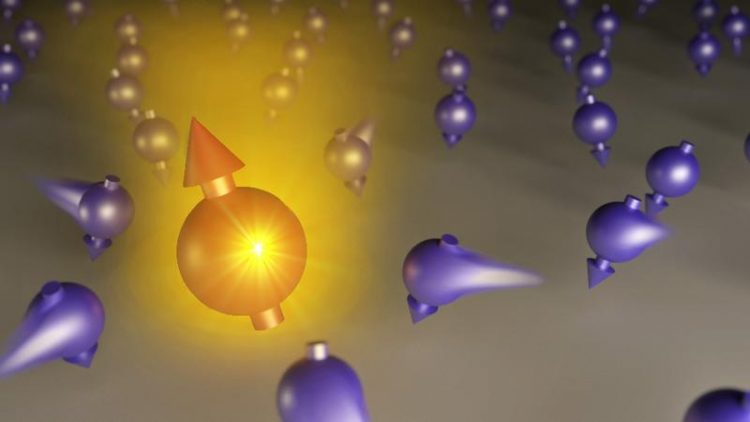Hot on the heels of quasiparticles

A polaron (orange) is formed amidst the electrons (violet) inside a solid. Credit: ETH Zurich / Meinrad Sidler
However, finding out precisely what quasiparticles arise inside a material and how they influence one another is not a simple task, but more akin to a large puzzle whose pieces fit together, little by little, through arduous research. In a combination of experimental and theoretical studies, Ataç Imamoglu and his collaborators at the Institute for Quantum Electronics at the ETH in Zurich have now succeeded in finding a new piece of the puzzle, which also helps to put a previously misplaced piece in its correct position.
Excitons and polarons
In solids quasiparticles can be created, for instance, when a photon is absorbed. The motional energy of electrons teeming about in a solid can only take values within well-defined ranges known as bands. A photon can promote an electron from a low-lying to a high-lying energy band, thus leaving behind a “hole” in the lower band.
The excited electron and the resulting hole attract each other through the electrostatic Coulomb force, and if that attraction is strong enough, the electron-hole pair can be viewed as a quasiparticle – an “exciton” is born. Two electrons and a hole can bind together to form a trion. When excitons and a large number of free electrons are simultaneously present however, the description of the qualitatively new – or “emergent” – properties of the material requires the introduction of new type of quasiparticles called Fermi polarons.
Quasiparticles in a semiconductor
Imamoglu and his colleagues wanted to find out the nature of quasiparticles that appear in a certain type of semiconductors in which electrons can only move in two dimensions. To do so, they took a single layer of molybdenum diselenide that is thousand times thinner than a micrometer and sandwiched it between two disks of boron nitride. They then added a layer of graphene in order to apply an electric voltage with which the density of electrons in the material could be controlled. Finally, everything was placed between two mirrors that formed an optical cavity.
With this complex experimental setup the physicists in Zurich could now study in detail how strongly the material absorbs light under different conditions. They found that when the semiconductor structure is optically excited, Fermi-polarons are formed – and not, as previously thought, excitons or trions. “So far, researchers – myself included – have misinterpreted the data available at the time in that respect”, admits Imamoglu. “With our new experiments we are now able to rectify that picture.”
Team effort with a guest scientist
“This was a team effort with essential contributions by Harvard professor Eugene Demler, who collaborated with us over several months when he was an ITS fellow”, says Meinrad Sidler who is a doctoral student in Imamoglus group. Since 2013 the Institute for Theoretical Studies (ITS) of the ETH has endeavoured to foster interdisciplinary research at the intersection between mathematics, theoretical physics and computer science. In particular, it wants to facilitate curiosity-driven research with the aim of finding the best ideas in unexpected places.
The study by Imamoglu and his colleagues, now published in “Nature Physics“, is a good example for how this principle can be successful. In his own research, Eugene Demler deals with ultracold atoms, studying how mixtures of bosonic and fermionic atoms behave. “His insight into polarons in atomic gases and solids have given our research important and interesting impulses, which we may not have come up with on our own”, says Imamoglu.
Light induced superconductivity
The insights they have gathered will most likely keep Imamoglu and his collaborators busy for some time to come, as the interactions between bosonic (such as excitons) and fermionic (electrons) particles are the topic of a large research project for which Imamoglu won an Advanced Grant of the European Research Council (ERC) last year, and is also supported by the National Centre of Competence in Research Quantum Science and Technology (NCCR QSIT). A better understanding of such mixtures would have important implications for basic research, but exciting applications also beckon. For instance, a key goal of the ERC project is the demonstration of control of superconductivity using lasers.
###
Reference
Sidler M, Back P, Cotlet O, Srivastava A, Fink T, Kroner M, Demler E, Imamoglu A: Fermi polaron-polaritons in charge-tunable atomically thin semiconductors. Nature Physics, 31 October 2016, doi: 10.1038/nphys3949 [http://dx.
Media Contact
All latest news from the category: Physics and Astronomy
This area deals with the fundamental laws and building blocks of nature and how they interact, the properties and the behavior of matter, and research into space and time and their structures.
innovations-report provides in-depth reports and articles on subjects such as astrophysics, laser technologies, nuclear, quantum, particle and solid-state physics, nanotechnologies, planetary research and findings (Mars, Venus) and developments related to the Hubble Telescope.
Newest articles

NASA: Mystery of life’s handedness deepens
The mystery of why life uses molecules with specific orientations has deepened with a NASA-funded discovery that RNA — a key molecule thought to have potentially held the instructions for…

What are the effects of historic lithium mining on water quality?
Study reveals low levels of common contaminants but high levels of other elements in waters associated with an abandoned lithium mine. Lithium ore and mining waste from a historic lithium…

Quantum-inspired design boosts efficiency of heat-to-electricity conversion
Rice engineers take unconventional route to improving thermophotovoltaic systems. Researchers at Rice University have found a new way to improve a key element of thermophotovoltaic (TPV) systems, which convert heat…



